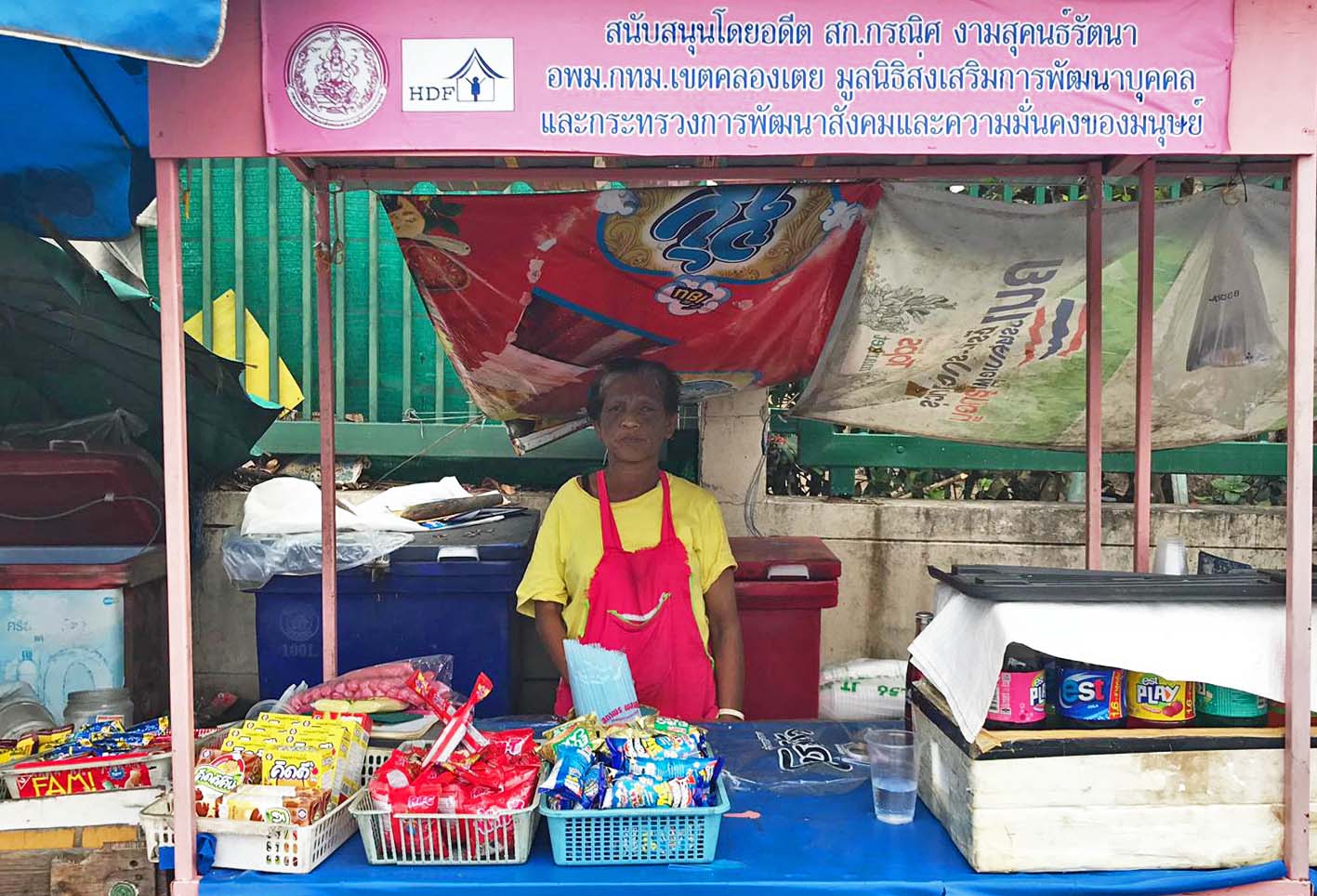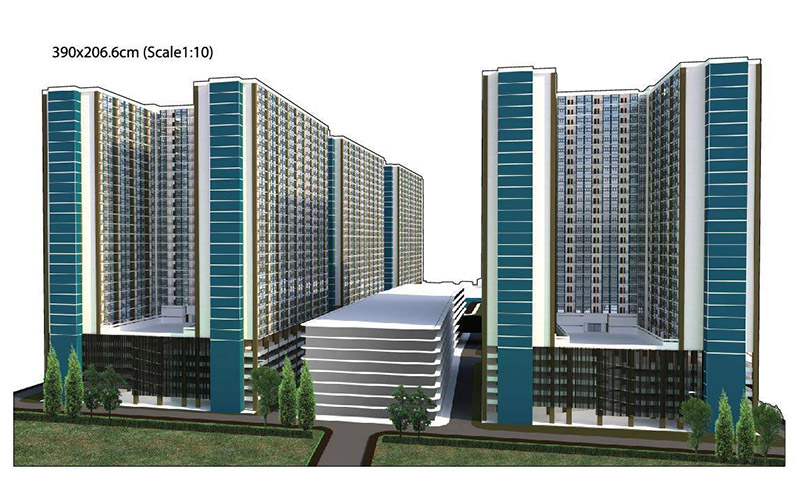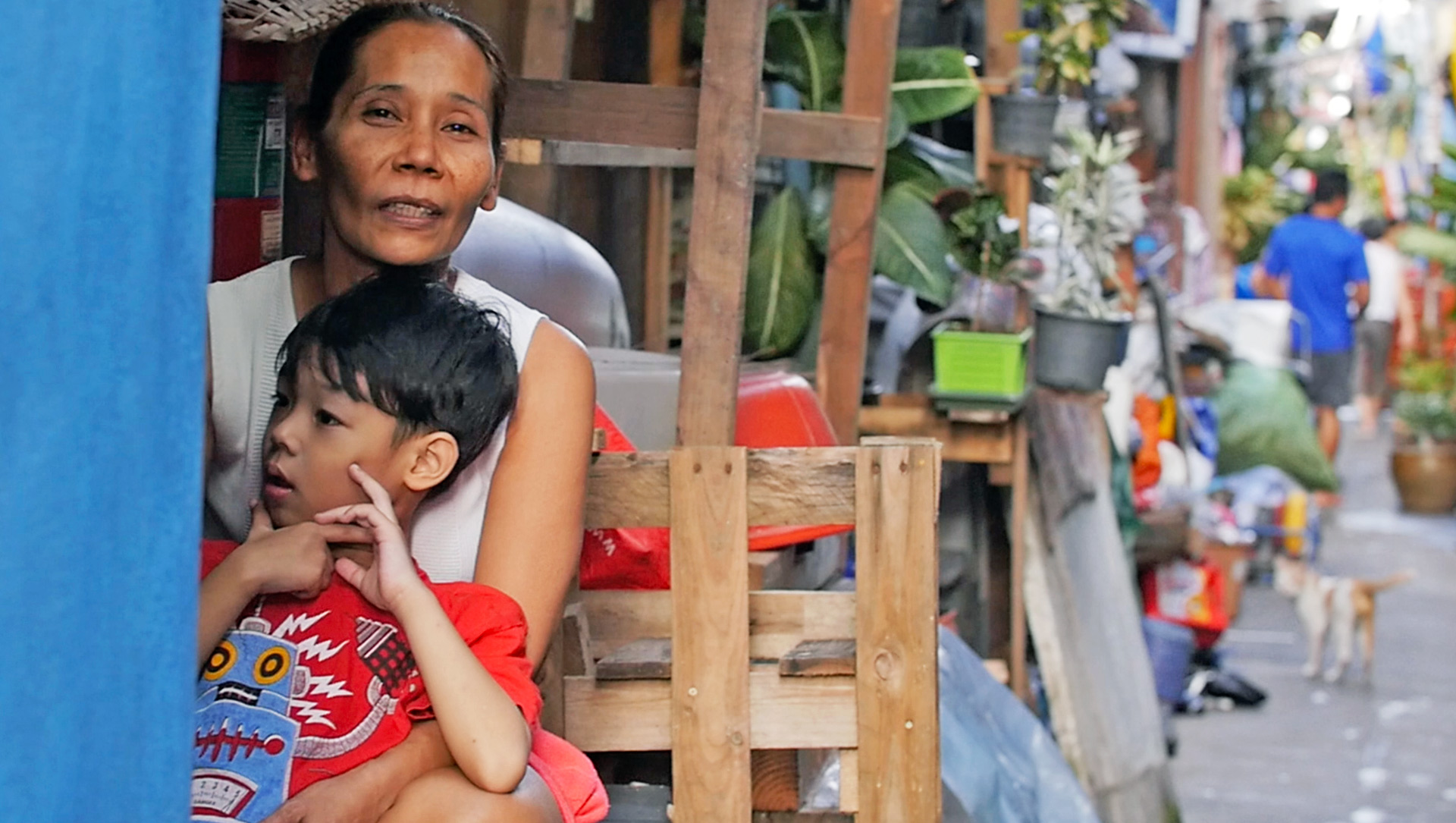Top photo: Coconuts
Being partially paralyzed may slow down Ratchani Cheausuwan, but it can’t stop her. Not when selling chips and soda at a borrowed stall in a squalid alley is the only way to feed the three children depending on her, one of whom is mentally disabled.
But the exhaustion felt by the 55-year-old, who lives in Bangkok’s sprawling Khlong Toei community, can’t compare to the months of terrible anxiety she’s felt since finding out they would be evicted, with no idea when it will happen or what she will do afterward.
“I live from hand to mouth every day. … I can barely make ends meet as is. I don’t know how I’ll be able to relocate. It’s going to be such a struggle,” she said as honking cars try to squeeze through the tiny soi.
Update: ‘Khlong Toei slum must be erased,’ official says
As plans move forward to remake swathes of Bangkok into high-end attractions for its wealthiest residents, Ratchani and tens of thousands like her have been excluded from the discussion. In conversation after conversation with some of the capital’s poorest residents, Coconuts Bangkok found anxiety and frustration was laced with the resigned fatalism of a marginalized population.

Multiply Ratchani’s fear by 100,000 and you have the upper estimate of residents, many who’ve lived in Khlong Toei since birth, who have been told everything they know will be demolished to make way for a new riverside mega mall.
Last week, about 30 residents seized the rare opportunity to confront the yellow-clad officials who hold their fates in hand at a community health center. The session turned angry as people demanded answers and unloaded frustration about being left in the dark.
“Just tell us when you want the land back! I think you know, but you won’t tell us!” an elderly man bellowed from the back of the room at the Port Authority.
“You keep telling us to wait for more information, but what happens when we actually get evicted? If we don’t even know when that’s going to happen, how are we going to make plans?” a woman called out, adding that it’s caused her debilitating stress.
Growing impatient, testy officials told the residents they should just wait to hear news.
“We don’t know yet, so we can’t tell you,” an unidentified Port Authority rep told the crowd.
“Can you guys just be patient? Why are you in such a hurry? Or do just really want to move into a condo?” he said, an apparent reference to one of several mooted compensation plans, none of which have been embraced by residents.
Progress at what price?
In recent years, Bangkok has awakened to the value of the many waterfront properties now occupied by depressed and dilapidated neighborhoods. Since the 2014 coup, entire communities have been evicted from along the capital’s canals and the Chao Phraya River, where people had lived for decades or longer without formal ownership.
Ambitions to remake the arterial river have now turned to Khlong Toei. Splashy plans to transform Bangkok’s biggest slum into an IconSiam-like complex of shops, hotels, stores and more were announced in May.
As for the 13,000 or so families living there? They were labeled illegal squatters, and officials revived shelved plans to force them out. In January, a “demonstration unit” of replacement housing was set up in an empty field with great fanfare.
No one could be bothered to ask the residents how they felt.
Now that development plans are being finalized, residents complain they’ve only been told what’s happening in extremely broad strokes. Maybe they will be evicted in three months – or maybe two years, depending on where they live. But no one seems to know how long anyone has – at least not the residents.

More than a ‘slum’
The Port Authority owns the land where, nearly 70 years ago, people looking for work in the capital began settling. It helped that it was next door to a busy dock that served as the nation’s main port for five decades. Today, it’s a warren of tenements and shanty housing maligned by many outside as a haven for drug abuse and criminality. But most of those living within are families struggling to get by.
“There are currently 26 communities living, both legally and illegally, in the 500 rai [80 hectares] of Khlong Toei that belong to the Port Authority,” said Penwadi Sangchan of the Duang Prateep Foundation.
Penwadi, who’s been working to assess the effects eviction will have on residents, said she understands the Port Authority’s desire to put the land to more profitable use.
“But this just means that the rich will keep getting richer, while the poor keep getting poorer – which will widen the kingdom’s economic gap more than ever,” she said.
While the Port Authority estimates there are about 12,500 families or 60,000 people to be evicted, Penwadi said surveys by community groups put the number closer to 100,000.
“The port can dismiss these people and say it’s their right to do whatever they want to their land, but this development also involves the government, whose responsibility is to take care of its citizens,” she said.
“We know that the land belongs to the government and that they have the right to do whatever they want to it, but I wish they would consider our livelihood when they make those decisions,” said a middle-aged woman who refused to give her name, saying she feared repercussions, something she “can’t afford right now.”
“Yeah, the area will look pretty, but at what cost?” she said with a sigh of resignation.
Eviction as erasure

The government has given residents three options.
The first – the only solution that would allow people to remain in the area – is to be relocated into four 25-story apartment buildings to be built a couple kilometers away on 58 rai (9 hectares) of former tanning factory land. Officials are calling it a “Smart Community” and say they plan to spend THB7.5 billion (about US$243 million) to build it, with bidding to begin next year.

There will be 6,144 identical units, all exactly 33 square meters. When the Port Authority first announced the plan in September, residents were excited. That quickly faded after they saw the sample apartment, Penwadi said.
“Can you imagine a family of seven, for example, living in a 33-square-meter room? And these buildings are high and, right now, only two elevators are proposed in each building,” she said. “Not to mention market vendors, who sell things on the side of the street outside of their homes. They will no longer have that source of income. And families who have pets – What are they going to do with their cats and dogs?”
And though residents were promised they could live rent-free, they will have to pay monthly maintenance fees and utility bills – a terrifying prospect for residents so impoverished community organizer Garat “Duang” Peumrab said they resort to using coal and gas to get by rather than pay for electricity.
For Ratchani, the impoverished 55-year-old disabled vendor born in Khlong Toei, the very concept of paying monthly fees is terrifying.
“I don’t know how I’d make the monthly fee or effectively move around in such a tall building,” she said, explaining that her right arm became paralyzed by an old injury.
“This stand is the only way I make a living. If they move me, how will we eat?”
The second option is to be relocated onto land in two far-flung districts on the outskirts: Min Buri and Nong Chok, about 35 kilometers and 53 kilometers, respectively, away. There, the government has promised 2,140 plots of land on a 34-hectare (214-rai) piece of land. Each plot, about 80sqm, is undeveloped and people would need to construct their homes.
The third option is to take an unspecified cash handout of similar value.
A half dozen or so residents told a reporter that few are optimistic about the latter two options.
“I don’t care about the building or the compensation. I don’t want it. I just don’t want to move,” said Sawan Beedinlae, who sells sweets by the side of the road. “Look at how busy Khlong Toei already is, can you imagine just how much more congested it will be if we all move into condos or a smaller piece of land? None of us wants to go. Most of us were born and raised here.”

Lessons unlearned
Community organizer Garat said that at an earlier community forum held to discuss the eviction threat, nearly everyone had the same question: What if we can’t get by after they move us?
Many remember what happened when forced government relocation was proven a failure three decades ago. After a chemical fire left about 5,000 people homeless in 1991, 480 apartments were built about 30 kilometers away.
Many people failed to find steady work and began commuting back to Khlong Toei to earn a living, he said. Transportation costs became too much to shoulder, and many simply returned to living in Khlong Toei.
“This time, the Port Authority isn’t even going to build housing for them. They’re just going to grant them [about 80sqm] of land each with a deed. But if they don’t have any money, what are they going to build their homes with?” he said.
It’s easy, he said, for those who’ve never experienced such poverty to say, “Oh they’re getting free land and they’re not happy about it?” But that betrays poor understanding of the basic realities faced by the poor, Garat said, such as needing to live near their place of work due to the cost of transportation.
Not all feel trapped by the eviction, however. Sompong Gingachorn, Khlong Toei born and raised, aired rare optimism that the government would make good on its promises and provide a better life.
“I believe in the government. I believe that they will find a better solution for us,” he said. Asked were he sad to leave his childhood home, he said that went without saying.
“Of course I’m sad. But what can I do?” he said. “It’s their land, we’re just living on it.”
Correction: An earlier version of this story misidentified a graphic rendering of a proposed Smart Community project. It has been removed and replaced with the correct image.



Reader Interactions